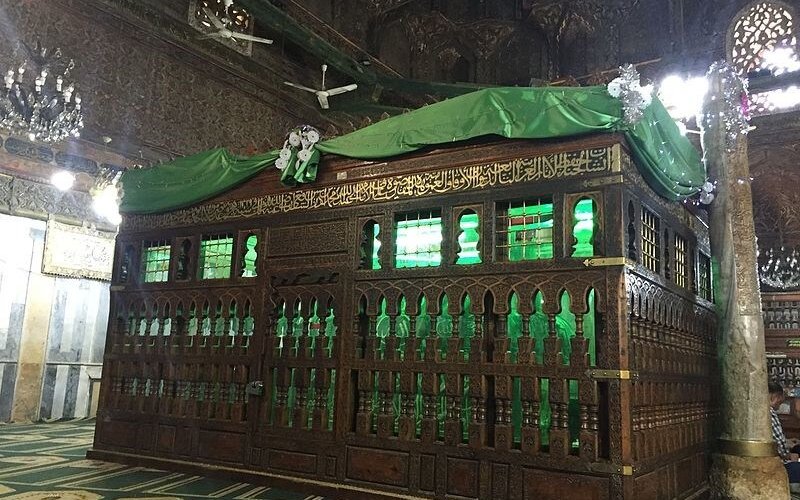Postcard from Cairo by RAS Director, Dr Alison Ohta
When people come to Cairo the first thing that comes to mind is a visit to the pyramids and the Egyptian Museum. However, Cairo’s rich heritage of Islamic architecture spanning a period of over 1000 years and its designation as a UNESCO world heritage site deserves greater attention. Last weekend, I had the opportunity to visit the Mausoleum of Imam al Shafi’i in ‘The City of the Dead’,[1] one of Cairo’s most important religious and architectural landmarks.
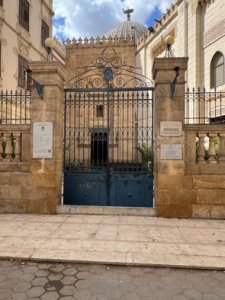
It is distinguished by its towering wooden dome atop of which sits its boat-shaped finial which used to be filled with grain for the birds. I had visited the mausoleum some 30 years ago and had memories of a very dark space with the cenotaph covered in thick green cloth so I was eager to see the results of the conservation project which had recently been completed by Athar Lina led by Mai al-Ibrashi, the renowned conservation architect.
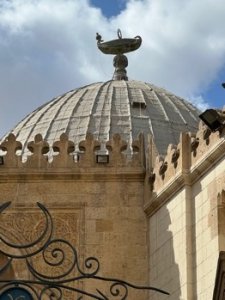
The work has revealed many interesting new details about the development of the site beginning with the ‘Abbasid period (9th century) and extending to the end of the 19th when the current mosque and entrance block were built by Khedive Tewfiq (1852-1892).
Imam al- Shafi’i was the founder of the Shafi’i school of Islamic jurisprudence, one of the 4 schools of Sunni Islam. He was born in Gaza and educated in Mecca and Baghdad. He travelled to Cairo in 813 C.E. where he studied under Sayyidna Nafisa (d. 830 C.E.), a prominent female scholar of hadith and descendant of the prophet. He died shortly afterwards in 819 C.E. and was buried in the family graveyard of the Egyptian scholar ‘Abd Allah ibn ‘Abd al-Hakam (d. 829 C.E.). The recent excavation of the site uncovered the remains of a shrine from the Fatimid period (909-1171 C.E.) which must have been built over the original grave.
In 1176-77 C.E., Salah al-Din al-Ayyubi built a madrasa (religious school) next to the shrine which was the most prestigious in Egypt during the Ayyubid period and has now disappeared, however, the beautiful wooden cenotaph and marble funerary column he commissioned for the mausoleum still mark al-Shafi‘i’s grave. In 1211 C.E., Al Malik al-Kamil (1180-1238) buried his mother next to cenotaph of Al-Shafi’i and rebuilt the shrine replacing the Fatimid structure with the monumental domed mausoleum that exists today.
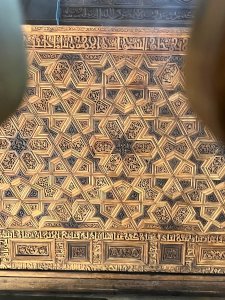
The cenotaph is decorated with inscriptions in kufic and naskh script with Qur’anic verses, and accounts of al-Shafi’i’s life. It is also decorated with panels of geometric ornamentation carved into the wood in the Ayyubid style. One of the Arabic inscriptions on the cenotaph reads: “This cenotaph was made for the Imam al-Shafi’i by Ubayd, the carpenter, known as Ibn Ma’ali, in the months of the year five hundred seventy-four. May God have mercy on him; may he [also] have mercy on those who are merciful toward him, those who call for mercy upon him, and upon all who worked with him–the woodworkers and carvers–and all the believers.”
Al Shafi’is mawlid (festival) is held during the Islamic month of Sha’ban which precedes the month of Ramadan attracting the sick and infirm who submit requests and letters seeking his baraka (blessing).

The interior of the mausoleum is now well-lit and the different registers of ornamentation that were added over the centuries can be easily identified. Some of the original details from the Ayyubid era include a wooden frieze along the walls and the wooden beams that would have supported lamps. Renovations were also carried out in the late fifteenth century by the Mamluk Sultan Qaytbay (r.1468-96) which included a painted interior dome and the addition of coloured marble on the lower wall panels. Qaytbay also restored the building’s three prayer niches. The Mamluk sultan, Qansuh al-Ghuri (r. 1501–16) also renovated the mausoleum, and in 1772 CE, the Ottoman governor, ‘Ali Bek al-Kabir undertook the restorations of the wooden dome of the mausoleum in addition to the polychrome decorative carvings, which cover the interior walls, the muqarnas and the dome.
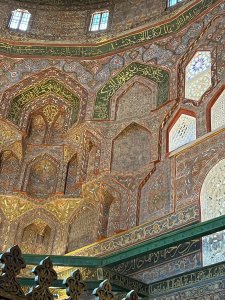
With an internal diameter of 15.30m, al-Shafi‘i’s wooden dome is the largest in Cairo. The lead sheets covering the dome hide a group of green tiles near the top, discovered during the restoration work of 1951. They were most likely added in the Mamluk period. Sultan al-Nasir Muhammad reportedly built a similar wooden dome covered with lead sheets and green tiles above his throne hall, al-Iwan al-Kabir, at the Citadel. Alternatively, Sultan al-Ghuri’s mausoleum was marked by a tiled brick dome (908-11 A.H./1503-05 C.E.).
The whole building has been very sympathetically conserved and a visitor’s centre has been added. Various signs outside give detailed accounts of the building with the addition of QR codes informing the visitor of the history of the area.
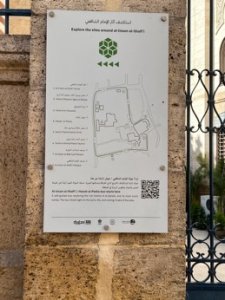
The harra ( lanes) around the mausoleum have not changed greatly over time with families still living next to the tombs in the cemetery. On my visit last week, I bumped into a group of ducks who hurried by, no doubt they may have had other things on their minds as duck cooked with mastic and cardamom is a common dish in Egypt.
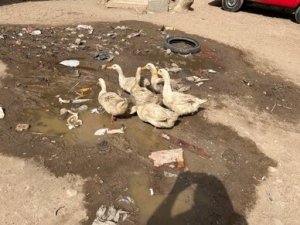
Al-Imam al-Shafi’i Conservation Project
The latest conservation project of al-Imam al-Shafi’i was undertaken by Megawra within the framework of its Athar Lina Initiative, under the supervision of the Ministry of Antiquities and with funding from the Ambassadors’ Fund for Cultural Preservation and additional funding from the Barakat Trust, UK. For detailed information about the building, the project excavation, and finds, click here.
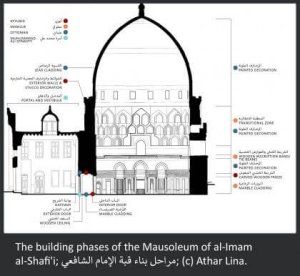
[1] ‘The City of the Dead’ contains the graves of the inhabitants of Cairo as well as the elaborate mausoleums of many of its rulers. It started with the early city of Fustat (founded in 642 CE) and continues to be used today.
~ ~ ~ ~ ~
An interesting new page has been added to our website: Founding Members of the Society Prosopography by Peter Collin. As Peter explains in his introduction to the page, his work “on the list of early members of the RAS started when Nancy Charley joined us as archivist. One of the first things she discovered…was an old leather-bound account book. This seemed uninteresting at first, but was to lead to more than two years of detailed research into the first members of the Society”.

Using archival sources, both within the Society and further afield, and standard reference works, Peter has collated biographies of many of the very early Fellows (1823-1825). These are presented on our website as a tool for further research, and any more information would be welcomed by Peter, by Matty Bradley (mb@royalasiaticsociety.org) the page-creator, and by myself, as archivist (nc@royalasiaticsociety.org). We are very grateful to Peter for all the work he has poured into this research which provides so many insights into those early members. You may find this page by following the link above or by navigating from our homepage menu under 2023 bicentenary.
~ ~ ~ ~ ~
Next week sees two events at the Society:
On Tuesday 5th March, 6.30 pm, Professor Dame Jessica Rawson will lecture on Gold, Horses and the Rise of the Silk Roads. Dame Jessica Rawson is an English art historian, curator and sinologist, specialising in Chinese art. She received a CBE in 1994 and was awarded the title of Dame in 2002 for services to oriental studies. We very much look forward to what she has to share on this interesting topic.
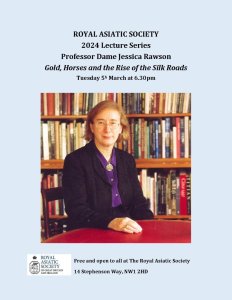
On Thursday 7th March, 6.30 pm, Robin Masefield will share insights from his latest publication, The World Administered by Irishmen: The Life and Times of Robert Hart and Irish Contemporaries in East Asia. While, the initial focus is on the Chinese Maritime Customs Service, and the Ulsterman Sir Robert Hart who led it for 45 years, the book brings together a treasure trove of other Irish people in East Asia – men from Ulster in the Customs Service; a nurse from Roscommon; a doctor from Cork; a diplomat from Meath; Hong Kong governors from Dublin; and many more. Robin Masefield worked in Hong Kong in the 1980s, and this is his third book with an Asian focus. He was awarded the CBE in 2003.
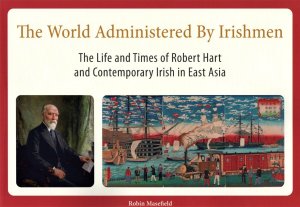
We hope you will be able to join us for one or both of these events.

